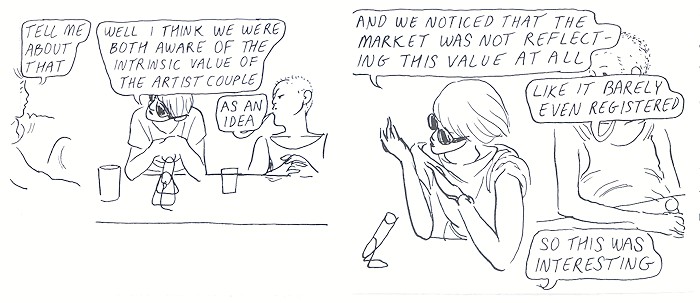El desdén por el avant-garde y lo que está fuera de la norma se extiende a cualquier ámbito de la discusión pública. En los comics es común encontrar aceptación y estima por un artista comercial como Jim Lee y silencio sepulcral al trabajo pictórico de Brian Chippendale. Que al hablar de Frank Quitely como el benchmark de lo offbeat estructural se le compare al mismo nivel de un Moebius, y sea también la vara con la que se mida desfavorablemente a un Chris Burnham, Nick Pitarra, Ian Bertram o Ramón Villalobos.
Son estándares y marcos de referencia que se emplean en la plática comiquera; herramientas útiles dentro del punto de vista del reviewer especializado. Pero obviamente no son ni serán el principio ni el fin, y es por eso que aspectos como la tolerancia, la apertura y el amplio criterio es esencial para la apreciación del arte en general, y en esto se incluye también a la propia narrativa gráfica.
Dentro de la doctrina personal de Blaise Larmee, discutida a fondo en blogposts anteriores, tenemos ahora un artículo muy interesante que nos habla de esta necesidad de considerar a la variedad y no cerrarse en preferencias personales o moldes establecidos históricamente. De tratar a los monolitos como guías en el camino, pero sin dejar de emprender o ser pionero en la búsqueda de nuestra sensibilidad/estilo como artista gráfico, ni mucho menos ignorarlo.
– – – – – – – – – –
Praxis/Practice
Blaise Larmee
Publicado originalmente en comets comets dot com entre 2010-2011.
I want to talk about the critical practice of using an ‘art paradigm’ in discussing creators who did not think of themselves as ‘artists’, but rather as ‘craftsmen’ or ‘journeymen’.
By discussing these craftsmen as artists the critic is:
1) Allocating resources (critical attention/books) to late career or post-career (i.e. dead) cartoonists when today’s young cartoonists are in need of these resources.
2) Creating a false lineage between old/dead cartoonists and young cartoonists.
3) Creating the illusion of discussion within comics about ‘art’, when in fact such discussion is almost non-existent.
The subjects of such criticism may include (*):
Ernie Bushmiller
George Herriman
Hank Ketcham
Frank King
Jack Kirby
Harvey Kurtzman
Charles Schultz
John Stanley
Rodolphe Töpffer
 While it is valuable for the comics economy to maintain the ‘public legacy’ of old/dead cartoonists, as institutional value is derived from the past, it is also valuable that they are remembered in a way that does not negatively alter the present. Spending too much on the past can leave the present and future in debt. The culture of comics has an oddly fascistic devotion to the past, and this devotion perpetuates the ‘same old shit’.
While it is valuable for the comics economy to maintain the ‘public legacy’ of old/dead cartoonists, as institutional value is derived from the past, it is also valuable that they are remembered in a way that does not negatively alter the present. Spending too much on the past can leave the present and future in debt. The culture of comics has an oddly fascistic devotion to the past, and this devotion perpetuates the ‘same old shit’.
I imagine some of the attraction for placing such creators under the ‘artist’ archetype is in order to ‘substantiate’ comics as a medium offering a ‘rich history’ with ‘inspired’ creators. But creating a falsely rich past inflates the currency of the present.
Austin English (foto, der.) is a young cartoonist who seems to be ‘inaccessible’ to most critics today. He seems highly concerned with craft but unconcerned with relating his craft to the comics history narrative. This lack of lineage provides the context for Eric Reynolds of Fantagraphics to say, “English isn’t really a cartoonist at heart.”
Some criteria for being considered an accomplished cartoonist include:
Development of an identifiable ‘style’ consistency within that style production of new formal gadgets clever usage of existent formal gadgets commitment to the ‘art of cartooning’.
Within this context, which appears to ‘cover all the bases’ of ‘art’ within cartooning, English has no precedent for discussion. He offers little consistency throughout his work as he navigates a constantly evolving visual language. He seems to be focused on the present and future as opposed to the past. As a creator he does not belong to any tree of tradition. The closest referents, say, Mark Beyer or Souther Salazar, are also generally excluded from such discussion.
Austin is just one example of a young cartoonist who is ironically being overlooked in critics’ search for ‘art’ in comics. ‘Ironically’ of course because he actually identifies as an artist and his work deserves being talked about as such.
(*) full disclosure: I don’t know much about these creators. I am not interested in them for various reasons.

